Quiz Answer Key and Fun Facts
1. Roald Amundsen (1872-1928) - Famous for being the leader of the first team to reach the South Pole (1911), what other first did Amundsen achieve (1903-1906)?
2. John James Audubon (1785-1851). Audubon is renowned for his extraordinary tome - 'Birds of America' but where was he born and where did he grow up?
3. John Richardson Auldjo (1805-1886). In 1827 John Auldjo decided to climb to the top of Europe's highest mountain, Mont Blanc. A few years later he explored another European mountain. Which mountain was that and why was it noteworthy?
4. Thomas Baines (1820-1875). In 1858, Thomas Baines, artist and adventurer joined David Livingstone's expedition to the Zambezi as artist and storekeeper. What artistic role did he fulfil previously, whilst still in his early twenties?
5. Henry Walter Bates (1825-1892). In 1848 Bates and Alfred Russell Wallace set off for the Amazon to collect specimens which they would send to London where an agent would sell them. This would help to fund their trip to South America. What noteworthy scientific observations did Bates make that has subsequently been named after him?
6. Ludwig Becker 1808-1861. In 1852, motivated by the gold rush, Becker moved from Van Diemans Land (now Tasmania) to Melbourne, Victoria. Several years later, he joined the Victorian Exploring Expedition. What happened to Becker on that Australian expedition?
7. William Beebe 1877-1962. At the New York Zoological Society, William Beebe was honorary curator, a position he held from 1919 to 1962. In the 1930s he gained international renown for what extraordinary feat of exploration?
8. Gertrude Bell 1868-1926. The BBC series ICONS (2019) celebrates the achievements of outstanding individuals of the 20th century. Included amongst the four candidates for icon status in the 'Explorers' category is Gertrude Bell. Which of the following statements is true for this remarkable woman?
9. Franz Boas (1858-1942). Franz Boas, born in Germany, emigrated to America in 1887, where he became known as the 'Father of American Anthropology'. What experience did he have in the early 1880s that led him to challenge the traditional approach to anthropology?
10. Sir Chris Bonington (1934 - ). Sir Chris Bonington is one of Britain's foremost mountaineers achieving many firsts, initially in the Alps and subsequently in the great ranges, primarily in the Himalaya. What did he do in 2014 to celebrate his 80th birthday, repeating a first that he had achieved 48 years previously?
Source: Author
MalStone
This quiz was reviewed by FunTrivia editor
bloomsby before going online.
Any errors found in FunTrivia content are routinely corrected through our feedback system.
